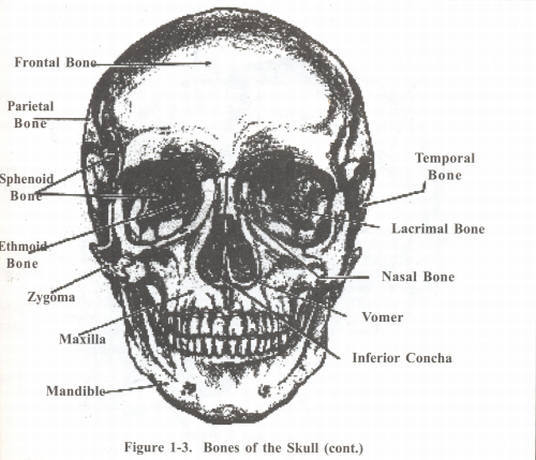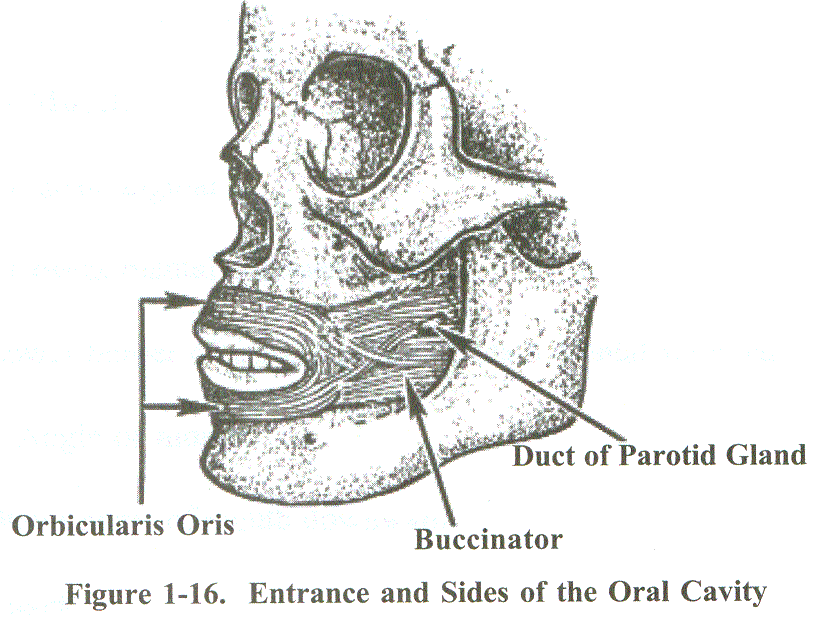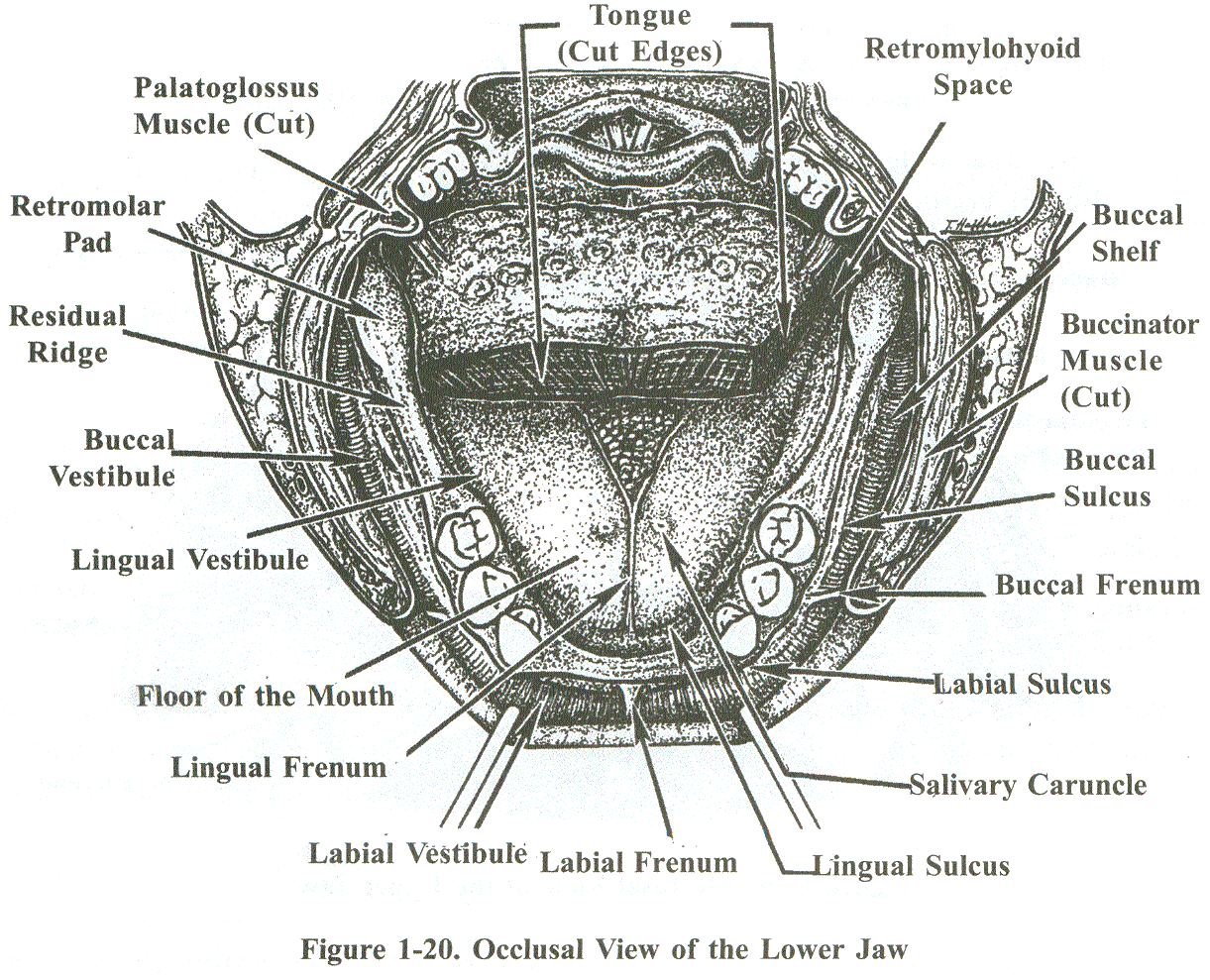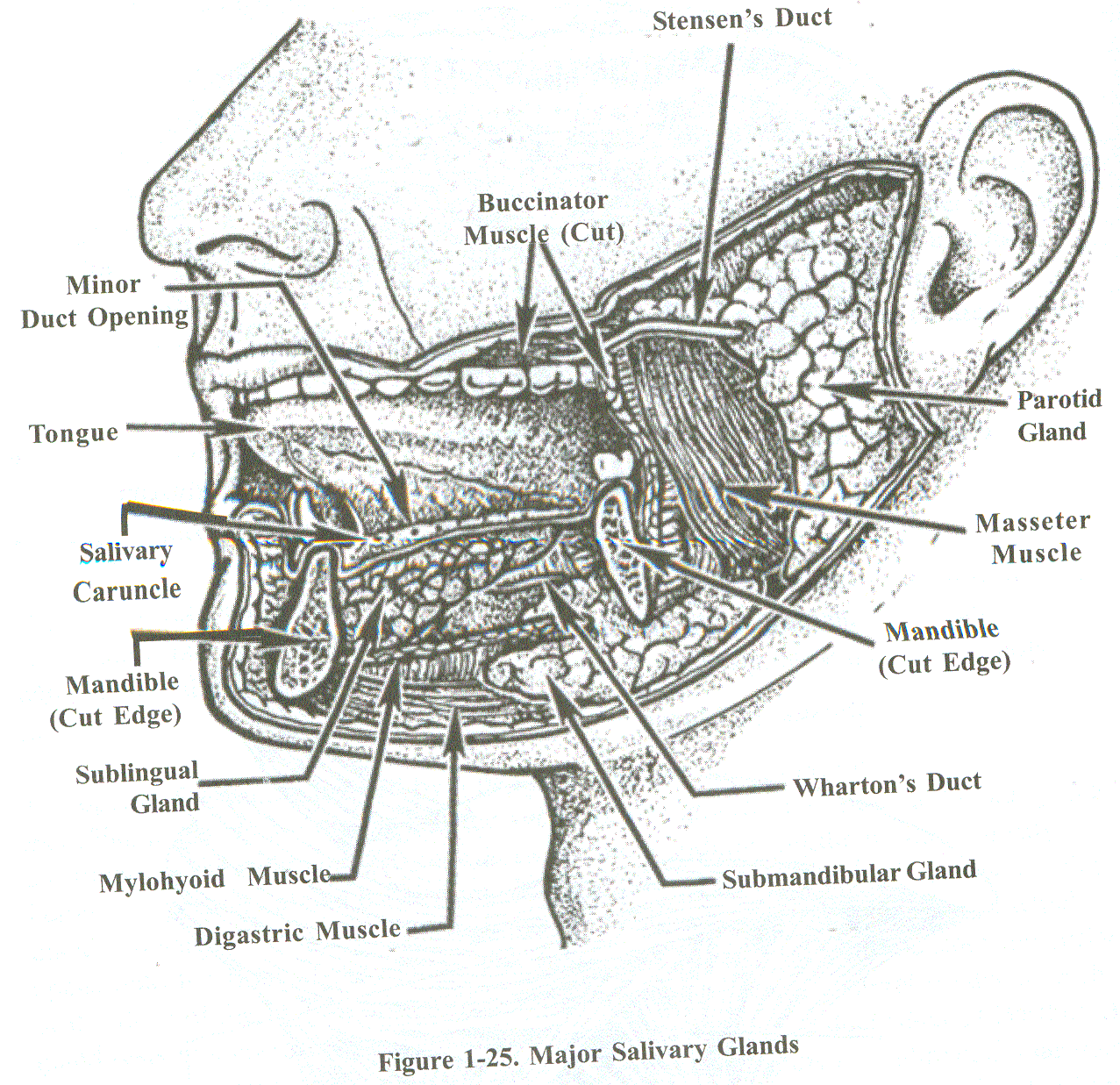1.
Anatomy of Facial and Oral Structures
v
Introduction to Anatomy
The study of anatomy has a language all its own. The terms have evolved over
many centuries. Most students think anatomical terms are hard to remember and
pronounce and, in some cases, they are. In any event, you must learn and
understand the terms that apply to the anatomical structures of dental interest
and you must be familiar with oral and dental anatomy.
n Basic Terminology
¨ General Reference Terms
 |
Anterior and Posterior. Anterior and posterior describe the
front-to-back relationship of one part of the body to another. For example,
the ear is posterior to (in back of) the eye, the nose is anterior to (in
front of) the ear, etc. |
 |
Internal (Medial) and External (Lateral).
The words internal and medial are synonyms, so are external and lateral.
These two terms describe the sideways relationship of one part of the body
to another using the midsagittal plane (see definition below) as a
reference. For example, the ear is external (or lateral) to the eye because
the ear is further from the midsagittal plane; the eye is internal (or
medial) to the ear because it is closer to the midsagittal plane. |
 |
Long Axis. The longitudinal center line of the body or any of
its parts. |
¨ Body Planes (See Figures 1-1 and 1-2.)
The study of geometry shows that a plane is perfectly flat, is infinitely
long and wide, and has no depth. For our purposes, a plane is a real or
imaginary slice made completely through a body. In anatomy, the slice is made to
study the details of the cut surfaces. The cut surfaces are called sections or
views. Planes can pass through a body in an infinite number of ways. There are
common, standard planes that produce standard views:
 |
Sagittal Plane.
A plane that parallels the
long axis and divides a body into right and left parts. A midsagittal plane
divides bodies into equal right and left sides. |
 |
Frontal Plane. A plane that parallels the long axis and divides a
body into anterior and posterior parts. |
 |
Transverse
(Horizontal) Plane. A plane that divides
a body into upper and lower parts. More specifically, it is a slice that
passes through a body at right angles (90 degrees) to the sagittal and
frontal planes. |
|
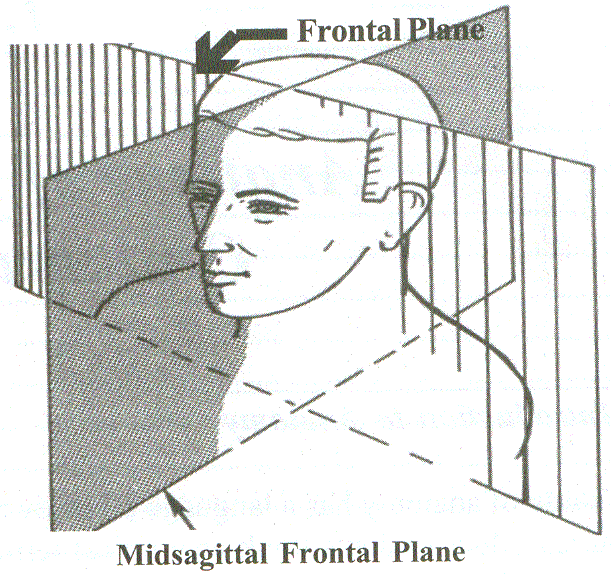
Figure 1-1. Sagittal and Frontal Planes |
|
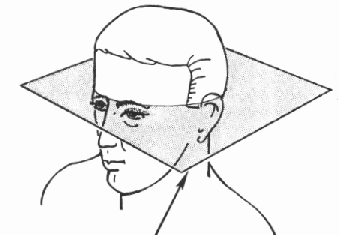 |
|
Figure 1-2. Tranverse Planes |
|
v Anatomical Terminology
Since anatomy is a descriptive science, a good deal of the
effort involved in learning it is associated with memorizing terms. However,
as more knowledge is acquired in this specialty through association,
structures and their functions are easily recalled. Nevertheless at the
outset, description of structures is generally remembered through a process of
memorization. Bear in mind that relating the function of a structure to its
morphology as well as to other structures is the basis for an in-depth
retention of anatomy.
While anatomical structure, some years ago, was described in
Latin, in most cases (although there are exceptions) this terminology has
given way to an anglicized version of the Latin. Other problems in anatomical
terminology relate to the fact that frequently a structure may have several
names. In fact in the latter part of the nineteenth century, estimates show
that there were some 50,000 terms in use but these only related to some 5,000
structures, for an average of 10 names per structure! Various systems have
been developed and reviewed for a structured arrangement for naming in
anatomy. In the 1950’s and 1960’s, the Nomina Anatomica was
developed in Paris on which all official terminology is based.
Anatomical terminology can be divided into 2 types: terms
that refer to components of the body and terms that refer to direction, e.g.,
proximal or distal.
Body Components
Head - caput, skull - cranium
Neck - collum or more commonly cervical
Trunk - 4 regions: dorsum (back), thorax (chest), abdomen,
pelvis.
Limbs - shoulder, arm, forearm, hand; hip, thigh, leg, foot.
Terms of Position
These terms are really the most complex. All references to
position refer to the living body standing in what is termed the anatomic
position. This is defined as: standing erect with the palms facing forward,
feet straight ahead. To this basic position all anatomic terms of direction
are referred.
Anterior/posterior - in man these terms are
synonymous with ventral/dorsal. However, in 4- legged animals they are not.
Anterior refers to toward the front of the body while posterior refers to
toward the back.
Superior/inferior - synonymous with cranial or caudal. Superior refers
to toward the head while inferior refers to the opposite direction.
Proximal/distal - refers to "closer to" or "further
from."
Planes
Sagittal - is a plane passing through the body from the front to the
back. Thus the body is divided into 2 halves. Note that the body does not have
to be divided into 2 equal portions unless divided by a midsagittal plane.
Coronal - divides the body by a plane passing at right angles to the
sagittal plane. Note that both sagittal and coronal also refer to sutures in
the skull which pass in the corresponding direction.
Transverse - a horizontal plane through the body.
In addition to these general descriptive terms we also employ terms of
movement.
Flexion/extension - these specify movement in muscles at a joint in the
opposite directions. Flexion indicates a movement which decreases the angle
between two bones while extension indicates a movement that increases the
angle. For example, in the anatomic position (i.e., with the palms of the
hands facing forward) muscles which cause movement at the elbow such that the
forearm bends upward toward the arm are considered "flexors" of the
forearm or of the elbow. On the contrary, muscles which cause the forearm to
move away from the arm are termed extensors.
Abduction/adduction - refer to the movement away from or towards the
median plane (a midsagittal plane) respectively.
Protraction/retraction - refer to an anterior movement or posterior
movement respectively. Used with movements of the mandible.
Rotation - refers to the movement of a body part about its longitudinal
axis.
|
¨ Bony Elevations
 |
Tubercle, Eminence, or
Tuberosity. All of these words describe
rather small, somewhat circular areas that are raised above the general
level of the surrounding bone. An elevation of bone that falls in this
category was specifically labeled as an eminence, a tuberosity, or a
tubercle by the person who originally described it. There might be little to
distinguish among these kinds of elevations as far as relative shape and
size are concerned. They just have to be memorized according to the names
they carry. |
 |
Ridge. A linear elevation on the surface of a bone. |
 |
Process. A very prominent projection from the central mass of a
bone. |
 |
Condyle. A rounded, convex, smooth surface on one of the bones
that forms a movable joint. |
¨ Bone Depressions and Channels
 |
Fovea. A shallow, cup-shaped depression or pit. |
 |
Fossa. A more or less longitudinal, rounded depression in the
surface of a bone. |
 |
Canal. A tubular channel through bone. The channel has at least
one entrance and one exit hole. A canal’s entrance or exit hole is called
a foramen. |
¨ Joints
Joints can be classified in a number of ways, one of the ways being the kind
of movement that the structure of the joint allows. There are three kinds of
joints found in the human skull.
 |
Synarthrosis or Immovable Joint. Most bones of the skull are
joined together along highly irregular, jigsaw puzzle-like lines called
sutures. A suture joint is classified as a synarthrosis. Bones joined along
suture lines in the skull are not totally immobile. Movement occurs, but it
is very limited. |
 |
Ginglymodiarthrodial Joint. Literally defined, this is a freely
movable, gliding, hinge joint. This relationship of one bone to another
allows the greatest range of movement of any joint type. The term
ginglymodiarthrodial specifically describes the temporomandibular joint that
unites the lower jaw with the rest of the skull. |
 |
Ellipsoidal Joint.
The type of joint
that exists between the occipital bone of the skull and the first
vertebra of the spinal column. There are two axes of motion at right
angles to each other in this joint, and both axes pass through the same
bone. This arrangement enables you to nod your head and rotate it from
side-to-side. |
¨ Muscles
The mass of a muscle is composed of many individual cells that are
capable of contracting. The force generated by the muscle as a whole depends
on how many cells in the muscle’s mass are contracting at any given time.
Muscles can pull (contract or shorten); they cannot push. A relaxed muscle
cannot get any longer unless another contracting muscle somewhere else is
forcing the extension. It should be obvious that a simple act like flexing
and extending a finger requires at least two different muscles. The muscles
used in flexing and extending a finger perform actions that are opposite one
another. The performance of an action by one muscle that is opposed to the
action of another is called antagonism. Besides having definite names,
muscles are described in terms of:
 |
Origin. A structure where a muscle attaches that moves the
least when a muscle contracts. |
 |
Insertion. A structure where a muscle attaches that has the
greater movement during contraction. |
 |
Action. The performance expected when a particular
muscle contracts. |
v
Bony Anatomy of the Head
n Overview
The skull is that portion of the human skeleton which makes up the bony
frame work of the head. For descriptive purposes, the skull is divided into an
upper, dome-shaped, cranial portion; and a lower or facial portion composed of
the eye sockets, nasal cavities, and both jaws. The adult skull is composed of
22 bones (8 cranial and 14 facial) (Figure 1-3).
¨ Cranial Bones. The 8
bones of the cranium are:
 |
Frontal |
 |
Parietal (right and left) |
 |
Occipital |
 |
Temporal (right and left) |
 |
Sphenoid |
 |
Ethmoid |
NOTE:
The shape and arrangement of these 8 bones
form a bony shell (cranium) that has a central cavity containing the brain. The
arched roof of the cranial cavity is called the vault and the floor of the
cavity is called the base.
¨ Facial Bones. There are 14
bones in the facial portion of the skull:
 |
Maxilla |
 |
Palatine |
 |
Zygomatic |
 |
Lacrimal |
 |
Nasal |
 |
Inferior concha |
 |
Vomer |
 |
Mandible |
NOTE:
There is only one vomer and
one mandible in a skull: the other facial bones are paired.
n Cranial and Facial Bones of Primary Interest in
Prosthetic Dentistry
Artificial replacements for missing natural teeth (dental prostheses) must
be made to fit jaw contours and work in harmony with muscle activity.
Therefore, we will discuss only those facial bones which give shape to soft
tissues within the mouth, serve as anchorage sites for muscles which move the
lower jaw, and give shape to the lower one-half of the face.
¨
Cranial Bones of Primary Interest
 |
Frontal |
 |
Parietal |
 |
Temporal |
 |
Sphenoid |
¨ Facial Bones of Primary Interest
 |
Maxilla |
 |
Palatine |
 |
Zygomatic |
 |
Mandible |
Particular features of these bones are important to remember for subsequent
reference in this publication and indeed, for the remainder of your technical
career.
n Particular Features of Cranial and Facial Bones
¨
Frontal Bone
The frontal bone is a single bone that forms the anterior of the cranial
vault, the roof of the eye sockets, and a small portion of the nasal cavity. A
temporal line can be found on both lateral surfaces of the frontal bone. The
line begins in the region of the eye socket and proceeds posteriorly, often
dividing into superior and inferior temporal lines near the posterior border
of the frontal bone (Figure 1-4).
¨
Parietal Bones
The paired parietal bones are located between the occipital and frontal
bones to form the largest portion of the top and sides of the cranium. The
parietal bones are marked by two semicircular bony ridges, the superior and
inferior temporal lines, which are the posterior continuation of the frontal
bone’s temporal line. The superior and inferior temporal lines rim the area
of origin of the temporal muscle (Figure 1-4).
¨
Temporal Bones
Temporal bones are the paired bones which form a portion of the right and
left sides of the skull below the parietal bones. The temporal bones extend
down onto the under surface of the cranium and contribute to the formation of
the cranial base. Each temporal bone articulates with the parietal above, the
sphenoid in front, and the occipital bone behind (Figures 1-4 and 1-5).
The significant features of the temporal bone are:
„ Mastoid process
„ Styloid process
„ Zygomatic process
„ Glenoid fossa
„ Articular eminence
„ Auditory canal or external auditory meatus
„ The convex posterior part of the temporal bone
(mastoid portion) is characterized by a rounded, downward projecting mastoid
process. The mastoid process presents a roughened exterior surface for
attaching several muscles of the neck.
„ The styloid process is a slender, tapering
spur of bone projecting downward from the under surface of the temporal bone.
The styloid process has sites of attachment for multiple muscles and ligaments
which then go to the mandible, the hyoid bone, the throat, and the tongue.
„
The zygomatic process is a projection from the approximate
center of each temporal bone which extends forward to form a part of the
zygomatic arch or cheek bone. This arch or so-called cheek bone is not one
continuous bone, but is made up of a number of parts. The zygomatic process of
the temporal bone forms the posterior part.
„
The glenoid fossa is a deep hollow on the under surface of the
base of the zygomatic process. The base of the zygomatic process is the place
where the process originates from the central mass of the temporal bone.
„
The articular eminence is a ramp-shaped prominence which extends
forward and downward from the anterior boundary of the glenoid fossa.
„
The auditory canal or external auditory meatus is a hole in the
bone found posterior to the glenoid fossa. It leads from the outside surface
of the base of the zygomatic process to the inner portions of the ear.
¨
Sphenoid Bone
The sphenoid bone resembles a bat with wings extended. It consists
of a central portion or body which is situated in the middle of the base of
the skull and three pairs of processes: two laterally extended greater wings,
two downward projecting pterygoid processes, and two lesser wings. The
features of the sphenoid bone we will discuss are:
„ Greater wings
„ Spine of the sphenoid
„ Pterygoid processes
„ Greater Wings (Figure 1-5). A
greater wing forms part of the surface contour of the cranium anterior to the
temporal bone, and also forms part of the eye socket.
„ Spine of the Sphenoid. This is just
inferior to the lateral, posterior, inferior border of the greater wing of the
sphenoid bone. The spine of the sphenoid is the site of attachment of the
sphenomandibular ligament.
„ Pterygoid Process (Figures 1-6 and
1-7). Extends downward from the junction of the body and greater wing of the
sphenoid on the right and left side. The pterygoid process is formed by the
union of two bony plates. The depression between the two plates is called the
pterygoid fossa. The pterygoid process is a site of origin for the internal
and external pterygoid muscles.
n Maxilla (Plural =
Maxillae)
The maxillae or upper jawbones are paired bones which unite in the midline
to give shape to the middle face, form a portion of the floor of the eye
socket and lateral wall of the nose, form the anterior two-thirds of the hard
palate, and support natural teeth in bony sockets (Figures 1-6, 1-7, and 1-8).
Each maxilla is irregularly shaped and is made up of a body and these four
processes:
„ Nasal process
„ Zygomatic process
„ Alveolar process
„ Palatine process
„ The nasal process forms a portion of the
lateral wall of the nose. Another name for nasal process is frontal
process.
„ The zygomatic process of the maxilla joins
with the zygomatic bone (zygoma) which, in turn, unites with the zygomatic
process of the temporal bone to form the zygomatic arch or cheekbone. The term
cheekbone, although popular, is incorrect. This so-called single bone is
actually made up of the three parts specified.
„ The roots of the maxillary teeth are surrounded
by the alveolar process. The alveolar processes of both maxillae unite
to form the maxillary arch. A maxillary tuberosity is found on both of the
distal ends of the maxillary arch. Proceeding even further posteriorly, the
maxillary tuberosities abruptly rise into deep depressions called the hamular
notches. The pterygoid process of the sphenoid bone joins with the posterior
aspect of a maxilla to form a hamular notch. The labial portion of the
alveolar bone follows the contours of the natural tooth roots; when a root is
large and prominent, the labial alveolar bone over the root is raised in
comparison to an alveolar area between roots. The labial alveolar bone
covering the root of the maxillary cuspid stands out so much that it has a
specific name, the cuspid eminence.
„ The palatine processes of the maxillae
join in the midline to form the anterior two-thirds of the hard palate. The
midline junction of the right and left palatine processes is called the median
palatine suture. An incisive foramen is found in the suture line immediately
behind the central incisor teeth. The foramen is an exit hole for nerves and
blood vessels which supply palatal tissue (Figure 1-8).
n Palatine Bones (Figures 1-7 and 1-8)
The paired, "L"- shaped palatine bones are located between
the maxillae and the sphenoid bone. A palatine bone forms parts of the floor and
outer wall of the nasal cavity, the floor of an eye socket, and the hard palate.
The horizontal plates of the palatine bones unite in the midline as the
posterior continuation of the medial palatine suture. (Read the next
sentence slowly and analyze its meaning.) The anterior border of the horizontal
plates of the palatine bones join with the posterior border of the palatine
processes of the maxillae to form the transverse palatine suture. You should
recall that the palatine processes of the maxillae form the anterior two-thirds
of the hard palate, and the horizontal plates of the palatine bones make up the
remaining posterior one-third.
n
Zygomatic Bone (Zygoma, Malar Bone)
The zygomatic bone is situated laterally to the maxilla. When the
zygomatic process of the maxilla, the zygomatic bone, and the zygomatic process
of the temporal bone are considered as a unit, the combination is called the
zygomatic arch (Figure 1-4).
n The Mandible (Figure 1-9)
The mandible or lower jaw is the only movable bone of the skull. This bone
gives shape to the lower portion of the face, provides sites of attachment for
the muscles which make it move, forms the framework for the floor of the mouth,
and supports the lower natural teeth. The mandible is connected to the skull by
the right and left temporomandibular joints. Within each joint the
condyle of the mandible fits into the glenoid fossa on the underside of the
temporal bone. In its movements, the condyle also travels onto the temporal bone’s
articular eminence. The articular eminence projects downward and forward from
the anterior border of the glenoid fossa.
„ The most prominent features of the mandible are its
horizontal body and two vertical projections known as rami (one
projection = ramus). The body is curved, somewhat like a horseshoe; at
the posterior limits of the body, the bone turns upward and slightly backward to
form the rami. As the inferior edge of the mandible is traced from anterior to
posterior, the sudden transition between the horizontal body and the relatively
vertical ramus is known as the mandibular angle (angle of the mandible).
Five processes are readily identifiable. The body of the mandible carries the alveolar
process which surrounds the root structure of individual teeth; each ramus
ends in two processes, and anteriorly positioned coronoid process and the
more posterior condyloid process. The deep, "U"- shaped
concavity between the two processes is called the mandibular notch. A condyloid
process can be divided into a condyle and a neck.
The top part of the condyle articulates with the glenoid fossa and articular
eminence of the temporal bone to form the temporomandibular joint.
„
The important external surface landmarks of the mandible are:
Mental Protuberance. A
roughly triangular prominence occurring in the midline near the inferior
border of the mandible (chin point).
Mental Foramen. The
anterior opening of the mandibular canal. The foramen is usually found
between and slightly below the first and second bicuspid root tips. The
inferior alveolar nerve passes within the mandibular canal and exits onto
the exterior surface of the mandible through the mental foramen to become
the mental nerve. Compression of the mental nerve by artificial dental
replacements must be avoided. It causes a feeling of pain or numbness.
External Oblique Ridge (Line).
The external oblique ridge extends at an oblique angle across the external
surface of the body of the mandible. This ridge begins at the lower anterior
edge of the ramus, continues onto the body, and progressively thins out to
end near the mental foramen. The external oblique ridge is most prominent in
the molar area and forms a distinct ledge with relation to the base of the
alveolar process. This ledge is called the buccal shelf.
„
The significant
internal landmarks of the mandible are the internal oblique or mylohyoid
ridge, genial tubercles, sublingual fossa, mandibular foramen, lingula, and
digastric fovea.
Mylohyoid Ridge. Located
on the internal surface of the mandible, the mylohyoid ridge occupies a
position similar to the external oblique ridge on the external surface. The
mylohyoid ridge passes forward and downward from the internal aspects of the
ramus onto the body of the mandible and fades out near the midline. This
ridge serves as the lateral line of origin for the mylohyoid muscle (the
mylohyoid muscle forms the major portion of the floor of the mouth).
Genial Tubercles.
Slightly above the lower border of the mandible in the midline, the bone is
elevated to a more or less sharply defined prominence forming the genial
tubercles.
Sublingual Fossa. A
shallow concavity which houses a portion of the sublingual gland, this
depression occurs just above the anterior part of the mylohyoid ridge.
Mandibular Foramen. The
foramen is located in almost the exact center of the inner surface of the
mandibular ramus. It opens into the mandibular canal.
Lingula. A bony
prominence on the anterior border of the mandibular foramen.
Digastric Fovea. A
depression found on both sides of the midline near the inferior lingual
border of the mandible.
n The Hyoid Bone
Since dentists and technicians are concerned with sites of anchorage for
muscles which move the lower jaw, the hyoid bone which is not a part of
the skull must be mentioned. The hyoid is a "U"- shaped bone
located anterior to the spinal column between the mandible and the larynx
(voice box). There is no joint-like union between the hyoid and any other
bone. It is suspended between the mandible above and the clavicle (collar
bone) below by suprahyoid (above the hyoid) and infrahyoid (below the hyoid)
muscle groups. Some of the syprahyoid muscles act to depress the lower jaw.
Those suprahyoid muscles which act to depress the mandible are described
below.
v
The Muscles of
Mastication and Depressors of the Mandible
n Overview
A person’s ability to move part of the body depends on a group of
specialized cells called the muscle fibers. Muscle fibers have the
ability to contract or shorten when stimulated by nerve impulses. A
typical muscle consists of a mass of muscle fibers bound together by
connective tissue. A muscle can generate varying degrees of power. This
variation in power is directly proportional to the number of fibers
within the muscle that are contracting at any given time. Muscles can
also stretch, but only because a muscle located elsewhere has
contracted and forced the extension. The simplest way to express
this is that muscles can only pull; they cannot push.
The two ends of a voluntary muscle usually attach to different bones.
In some instances, one end of a muscle may attach in soft tissue such as
skin. Some of the very small muscles that give expression to the face
have both ends attached to soft tissue. In any case, the muscle
attachment site which remains relatively stationary when the muscle
contracts is known as the origin. The muscle attachment site
having the greater movement during the contraction is called the insertion.
A description of the movements which take place as a result of muscle
contraction is called the action.
Two muscle groups are responsible for executing the movements that
the mandible is capable of making. They are the muscles of mastication,
and the depressor muscles of the mandible. The muscles of mastication
enable the lower jaw to make closing, opening, protrusive, and retrusive
movements along with movements to the right and left sides. The
depressors of the mandible act to open the lower jaw widely, a function
which the muscles of mastication cannot perform.
n Muscles of Mastication
There are four, paired muscles of mastication. They are the masseters,
the temporals, the internal pterygoids, and the external pterygoids.
¨ Masseter (Figure 1-10):
 |
Origin. Zygomatic arch. |
 |
Insertion. Lateral surface of the ramus of the mandible. |
 |
Action. The masseter has two actions. They are elevation of
the mandible and elevation of the mandible combined with retrusion. |
¨ Temporal (Figure 1-10):
 |
Origin.
The origin of this muscle is broadly spread out (fan-shaped) on the side of
the skull. It covers the majority of the temporal bone and lesser portions
of the frontal and parietal bones. The upper margin of the muscle follows
the superior temporal line. |
 |
Insertion. The temporal muscle inserts on the coronoid process of
the mandible. |
 |
Action. The temporal muscle acts in unison with the masseter and
internal pterygoid muscles to close the jaws. Very importantly, it also
helps to retrude or pull back the mandible. |
¨ Internal Pterygoid (Figure 1-11):
 |
Origin. Palatine bone and the pterygoid process of the sphenoid
bone. |
 |
Insertion. Internal (medial) surface of the ramus of the mandible. |
 |
Action. The internal pterygoid acts with the masseter and temporal
muscles to close the lower jaw. Some authors claim that when one internal
pterygoid muscle contracts independently of its paired mate, the internal
pterygoid muscle assists in moving the mandible sideways. |
¨ External Pterygoid (Figure 1-12)
 |
Origin. Pterygoid process and greater wing of the sphenoid. |
 |
Insertion. Neck of the condyloid process of the mandible. |
 |
Action. When both external pterygoid muscles contract together, the
mandible is pulled forward into protrusion. (Coincident with a protrusive
movement, the mandible opens slightly.) When one muscle contracts
independently of the other, the mandible pivots and shifts to the opposite
side (lateral excursion). |
n Depressor Muscles (Figures 1-13 and 1-14)
The depressor muscles of the mandible all have the hyoid bone in common as an
attachment site. When the hyoid bone is immobilized by a contraction of the
muscles below it, the contraction of the depressor muscles located between
the hyoid bone and the mandible pulls the mandible downward (open the
mouth). The suprahyoid depressors of the mandible are the mylohyoid,
geniohyoid, and digastric muscles.
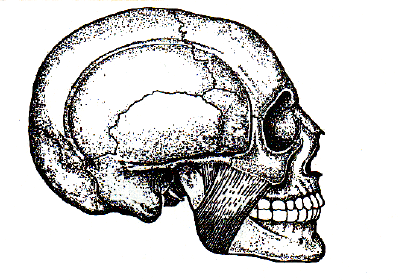
Masseter Muscle
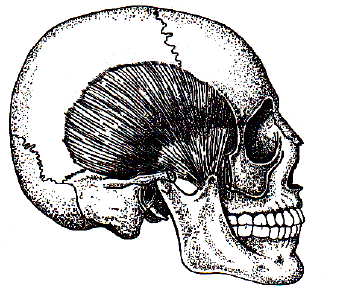
Figure 1-10. Temporal Muscle
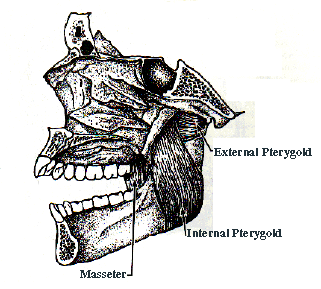
Figure 1-11. Medial View of the
Internal Pterygoid Muscle
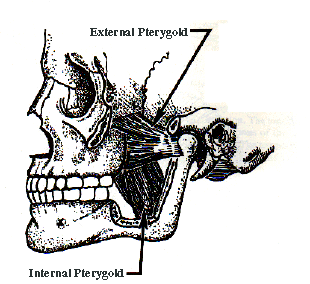
Figure 1-12. Lateral View of the
External Pterygoid Muscle
¨ Mylohyoid Muscle
Attachment Sites
The paired mylohyoid muscles are attached to the mylohyoid
lines on the internal surfaces of the mandible, the right and left mylohyoid
muscle join in the midline to form the floor of the mouth, and the posterior
end of this midline junction attaches to the hyoid bone.
¨ Geniohyoid Muscle
Attachment Sites
The two geniohydid muscles are found next to each
other, on each side of the midline, directly on top of the mylohyoid muscles.
The sites of the attachment are the genial tubercles and the hyoid bone.
¨ Digastric Muscle
Attachment Sites
The digastric muscle bundle is divided into an anterior
belly and a posterior belly by a short tendon. This intermediate tendon passes
through a loop of fibrous tissue secured to the body of the hyoid bone. The end
of the anterior belly attaches to the digastric fovea and the posterior belly
fastens onto the mastoid process of the temporal bone.
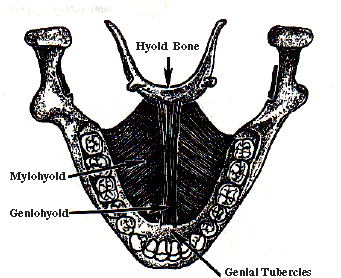
v
Facial Expression Muscles
n Overview (Figure 1-15)
Eight paired muscles of expression in combination with the single,
orbicularis oris muscle control movements of the lips and cheeks. The teeth
and alveolar processes of the jaws support this group of muscles against
collapse into the oral cavity. When natural teeth are extracted, facial muscle
support must be maintained by replacing the missing teeth. A person’s
appearance can be dramatically affected by the position of the artificial
teeth. Inadequate support makes people look older, and excessive support
distorts a person’s features by making them appear stretched.
The muscles of facial expression also play an important part in forming the
anterior and lateral portions of maxillary and mandibular impression borders.
This is because all of these muscles can alter the depth of vestibular sulci
(below) in one way or another. If impression borders are not properly extended
and shaped, the muscles act to unseat the dentures.
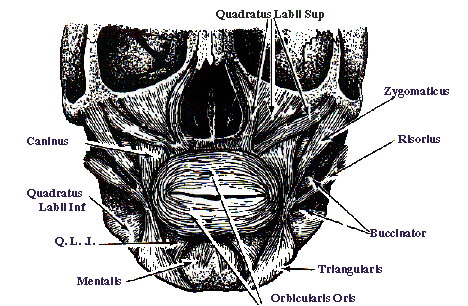
Figure 1-15.
Muscles of Facial Expression
n Muscles of Facial Expression
¨ Orbicularis Oris
This ring-like muscle lies within the upper and lower lips and completely
surrounds the opening to the mouth. When the orbicularis oris contracts,
it causes the lips to close. The orbicularis has no real bony origin. Instead,
it is entirely rimmed by the insertions of other muscles of facial expression,
most of which do originate on bone. Certain muscles of expression that insert
into the orbicularis oris act to draw the corners of the mouth backward, some
depress the lower lip, and others elevate the upper lip.
¨ Quadrates Labii Superioris Muscle
 |
Form. Flat, triangular. |
 |
Position. Lateral to the nose. |
 |
Origin
(by three heads). |
- Angular. Frontal process of the maxilla.
- lnfraorbital. Inferior margin of the orbit.
- Zygomatic. Anterior surface of the zygomatic bone.
 |
Insertion. Fibers of the orbicularis oris beneath the nostrils. |
 |
Action. Elevates the upper lip, widens the nasal opening,
and raises the corner of the nose. |
¨ Zygomaticus Muscle
 |
Form. Oblong, flat, and cylindrical. |
 |
Position. Lateral to, and above, angle of mouth. |
 |
Origin. Zygomatic bone, lateral to quadrates labii superioris
muscle. |
 |
Insertion. Skin at angle of mouth. |
 |
Action. Draws angle of mouth laterally and upward. |
¨ Caninus Muscle
 |
Form. Flat, triangular. |
 |
Position. In canine fossa of the maxilla, covered by the quadrates
labii superioris muscle. |
 |
Origin. Canine fossa. |
 |
Insertion. Angle of mouth. |
 |
Action. Lifts angle of mouth upward, lifts lower lip, and helps to
close mouth. |
¨ Risorius Muscle
 | Form, Flat, triangular. |
 |
Position. Lateral to angle of mouth. |
 |
Origin. Tissue over the masseter muscle and parotid gland. |
 |
Insertion. Unites at angle of mouth with triangularis muscle. |
 |
Action. Draws angle of mouth laterally, causes smile and dimple. |
¨ Quadrates Labii Inferioris Muscle
 |
Form. Flat, quadrangular. |
 |
Position. Covers mental foramen. |
 |
Origin. Lower border of mandible. |
 |
Insertion. Skin of lower lip. |
 |
Action. Depresses and inverts lower lip. |
¨ Triangularis Muscle
 |
Form. Flat, quadrangular |
 |
Position. Covers mental foramen. |
 |
Origin. Lower border of mandible just beneath mental foramen. |
 |
Insertion. Angle of mouth. |
 |
Action. Draws angle of mouth downward. |
¨ Mentalis Muscle
 |
Form. Thick, cylindrical, short. |
 |
Position. On chin, deep to quadrates labii inferioris muscle. |
 |
Origin. Mandible, deep to quadrates labii inferioris muscle. |
 |
Insertion. Obliquely downward to skin of chin. |
 | Action. Lifts and wrinkles skin of chin. |
¨ Buccinator Muscle
The buccinator muscle is a thin, broad band of muscle tissue that forms the
innermost muscle wall of a cheek. A buccinator muscle has three sites of origin.
They are the pterygomandibular raphe (ligament) that originates behind
the maxillary tuberosity and inserts at the posterior end of the mandible’s
mylohyoid line; in the maxilla, the buccinator muscle originates on the buccal
surface of the alveolar process, immediately above the root tips of the molar
teeth; the third area of origin is the external oblique ridge of the mandible.
The muscle fibers of the buccinator run parallel to the occlusal plane of the
teeth, and have a broad zone of insertion into the orbicularis oris at the
corner of the mouth. Besides being muscles of facial expression, some anatomists
classify the buccinators as accessory muscles of mastication. The primary
functions of these muscles are to pull the corners of the mouth laterally and to
hold food between the teeth while chewing.
v
Intraoral Soft
Tissue Anatomy
n General Overview
The muscles that form the sides, the entrance, and the floor of the oral
cavity are the buccinators, the orbicularis oris, and the mylohyoids
(in that order) (Figure 1-16). The skin of the interior of the mouth is called
oral mucous membrane or mucosa. In places like the alveolar
processes and the hard palate of the upper jaw, the mucous membrane is firmly
and directly attached to bone. This kind of mucosa presents a stable surface.
In other areas like the lips and the floor of the mouth, the mucous
membrane covers active muscles that are constantly in motion; for example, the
strong, muscular tongue is almost always moving. A removable prosthesis is
built to use stable mucosa for support, and avoid areas of high muscle
activity. There are soft tissue landmarks in the mouth that stay in the same
places after natural teeth are extracted; these landmarks are valuable aids in
prosthesis construction. Knowing where they are is the first step in being
able to use the landmarks to advantage.
n Mucous Membrane (Figure 1-17 and 1-18)
Mucous membrane is the skin that lines the mouth.
¨ Mucous Membrane of the Alveolar Process
The mucous membrane of the alveolar process is divided into gingiva and
alveolar mucosa.
 |
Gingiva. Gingiva covers the crestal
three-fourths of the alveolar process. There are two kinds of gingiva, free
and attached. Free gingiva is about 0.5 mm wide and is found at the neck
of a tooth. The attached gingiva is continuous with the free gingiva and is
tightly bound to bone. The attached gingival band varies between 2 and 9 mm
wide, the widest part is found in the anterior regions. |
 |
Alveolar Mucosa. Covers the basal one-fourth of the alveolar
process. Alveolar mucosa is very mobile because it is loosely bound to
underlying bone. |
¨ Mucous Membrane of the Hard Palate
The mucous membrane of the hard palate consists of attached gingiva.
n Vestibule
The vestibules consist of two potential spaces. One vestibule is found
between the facial aspect of the teeth and the internal surfaces of the cheeks
and lips, and the other vestibule is found between the lingual aspect of the
mandibular teeth and the tongue.
n
Upper Jaw (Figures 1-18, 1-19, 1-31)
¨ Alveolar Process
The alveolar process is a process of the maxilla that surrounds the
roots of natural teeth. The right and left alveolar processes combine to form
the maxillary arch.
¨ Alveolar Ridge (Residual Ridge)
The residual ridge is the remnant of the alveolar process which
originally contained sockets for natural teeth. After natural teeth are
extracted, the alveolar ridge can be expected to get smaller (resorb). The rate
of resorption varies considerably from person to person.
¨ Maxillary Tuberosity
The maxillary tuberosity is the most distal (posterior) portion of the
maxillary alveolar ridge.
¨ Hamular Notch
The hamular notch is a deep depression located posterior to the
maxillary tuberosity. The depths of this depression is part of a series of
guides used to determine the posterior border of a maxillary denture.
¨ Palate
The palate extends from the roof of the mouth all the way back to the uvula:
 |
Hard Palate. The hard palate is made up of the anterior
two-thirds of the palatal vault supported by bone (palatine processes of the
maxillae and the horizontal plates of the palatine bones). |
 |
Soft Palate. The soft palate is made up of the posterior
one-third of the palatal vault that is not supported by bone. The soft
palate is a muscular extension from the posterior edge of the hard palate,
and the soft palate is very mobile, especially while speaking and
swallowing. |
¨ Incisive Papilla
You will recall that the incisive foramen is located in the midline of the
hard palate, immediately behind the central incisor teeth. The foramen is an
exit hole for blood vessels and nerves. There is a definite bump or prominence
in the oral mucosa which covers this hole in bone. The soft tissue bump
immediately over the incisive foramen is called the incisive papilla.
Since the incisive papilla is visible in the exact midline of the hard
palate, just behind the natural central incisors, the papilla is a reliable
guide for determining the midline relationships of upper anterior denture teeth.
¨ Rugae
Rugae are irregular ridges of fibrous tissue found in the anterior
one-third of the hard palate.
¨ Median Palatine Raphe
The medial palatine raphe is a slight tissue elevation which occurs in
the midline of the hard palate, immediately over the median palatine suture.
¨ Vibrating Line
When a dentist looks at a patient’s entire palatal vault, it is easy to see
an abrupt transition between the unmoving hard palate and the highly mobile soft
palate. The vibrating line is the line of flexion between the hard and
soft palates. The line most frequently falls between the two hamular notches, on
or near the palatine foveae in the midline.
¨ Palatine Fovea
There are two palatine foveae. The two fovea are
located on either side of the midline on, or very near the vibrating line. The
palatine foveae are depressions made by two groupings of minor palatine salivary
glands.
NOTE: The vibrating
line is the dentist’s guide to determining the posterior border of an upper
denture. In the absence of specific instructions from a dentist, the hamular
notches and the palatine foveae are your guide for determining the posterior
border of an upper denture.
¨ Labial Frenum
The labial frenum is a narrow fold of oral mucosa,
which is found in the approximate midline. It extends from the inner surface of
the lip to the labial surface of the alveolar ridge. The labial frenum is not
a reliable guide for determining the midline of the face when natural teeth are
absent.
¨ Buccal Frenum
There are two buccal frena. These frena are located on each side of
the arch, usually in the first bicuspid region. Each frenum extends from the
mucosa of the cheek to the buccal aspect of the alveolar ridge.
¨ Sulci
The maxillary sulcus is a groove formed by the mucosa of the cheek or lip and
the mucosa at the base of the alveolar ridge. The portion of the sulcus which
lies between the labial and buccal frena is called the labial sulcus, and
the part of the sulcus between the buccal frenum and the hamular notch is the buccal
sulcus. The muscles shaping the sulcus cause its depth to change with every
facial expression a person makes.
n
Lower Jaw
(Figures 1-18, 1-20, and 1-21)
¨ Alveolar Process
The alveolar process is the process of the mandible that surrounds the
roots of the natural teeth. The right and left alveolar processes combine to
form the mandibular arch. After natural teeth are extracted, the remnant
of the alveolar process is called the alveolar or residual ridge.
As time goes on, a residual ridge usually resorbs (gets smaller).
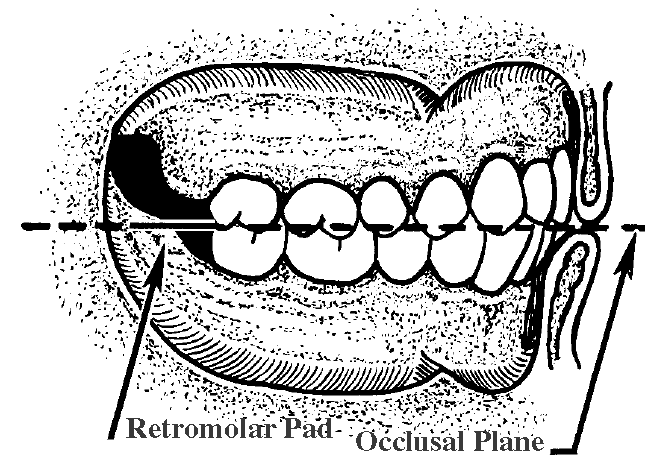 |
Figure 1-22. Relationship of the Retromolar Pads to the Occlusal Plane
¨ Retromolar Pad
A pear-shaped mass of soft tissue located at the posterior end of the
mandibular alveolar ridge (Figure 1-22). The retromolar pads are
important for these reasons:
 |
When maxillary and mandibular natural teeth are brought together, a
plane of contact automatically forms between the occlusal surfaces of the
upper and lower teeth (occlusal plane). When this plane of contact is
projected posteriorly, it intersects with the mandible at two points; one
point is on each side of the arch. These points are about two-thirds of the
way up the height of the retromolar pads. The position of the pads remains
constant, even after the natural teeth are extracted. These facts ensure
that the pads are an excellent guide for determining and setting the
plane of occlusion between upper and lower denture teeth. |
 |
The pads serve as bilateral, distal support for a mandibular denture. Covering the pads with the denture base helps reduce the rate of alveolar
ridge resorption. |
¨ Buccal Shelf
The buccal shelf is a ledge located buccal to the base of the alveolar
ridge in the bicuspid and molar regions. Laterally, the shelf extends from the
alveolar ridge to the external oblique line. A buccal shelf is barely observable
when the alveolar ridge is large (the shelf increases in size as the ridge
resorbs). The buccal shelf is a support area for a mandibular denture,
especially when the remaining alveolar ridge is relatively small.
¨ Mental Foramen
As described previously, the mental foramen is a hole in bone
ordinarily found on the buccal surface of the alveolar ridge. It is located
between and slightly below the root tips of the first and second bicuspid teeth.
There is no tissue bump over the hole as in the case of the incisive foramen.
When resorption of the alveolar ridge is drastic, the mental foramen is found
below the oral mucosa on the crest of the alveolar process. In these cases,
relief of the denture is necessary to avoid excessive pressure on the nerve
fibers which exit from this foramen, compression results in loss of feeling in
the lower lip. Relief in this case is defined as space provided between
the under surface of the denture and the soft tissue to reduce or eliminate
pressure on certain anatomical structures.
¨ Frena
The labial and buccal frena of the mandible are in
corresponding positions to their counterparts in the upper jaw. Also, a lingual
frenum can be seen in the floor of the mouth when the tongue is raised. The lingual
frenum is present in the approximate midline and extends from the floor of
the mouth to the lingual surface of the alveolar ridge.
¨ Sulci
Sulci rise and fall with facial expressions and tongue movements:
 |
Labial Sulcus. The labial sulcus of the lower jaw lies at the
base of the alveolar ridge between labial and buccal frena. |
 |
Buccal Sulcus. The buccal sulcus extends posteriorly from the
buccal frenum to the buccal aspect of the retromolar pad. |
 |
Lingual Sulcus. The lingual sulcus is the groove formed by the
floor of the mouth as it turns up onto the lingual aspect of the alveolar
ridge. |
¨ Floor of the Mouth
The anterior two-thirds of the floor of the mouth is formed by the
union of the right and left mylohyoid muscles in the midline. The depth of the
floor of the mouth in relation to the mandibular alveolar ridge constantly
changes due to factors such as mylohyoid muscle contractions, tongue movements,
and swallowing activities. The posterior one-third of the lingual sulcus area is
called the retromylohyoid space; distally, the area is shaped by
the palatoglossus muscle.
n
The Tongue (Figures 1-23 and 1-24)
The tongue is a muscular organ that contains specialized cells for
detecting the presence of chemicals in the food we eat. The brain interprets
this chemical detection process as taste. The tongue's many different sets of
muscles enable it to make the complex movements associated with speaking and
with chewing food. The constant motion of the tongue represents a powerful
force, and no artificial dental replacement can restrict that motion for long.
If a prosthesis is not constructed to work in harmony with the tongue, it will
fail. For example, the tongue can maintain a denture in position or throw it
out, depending on how the lingual surfaces and borders of the denture are
shaped. The tongue is animated by two muscle groups, the intrinsic and
extrinsic.
¨ Intrinsic Muscles
Intrinsic muscles represent the substance of the tongue. They are
responsible for the tongue's ability to change shape.
¨ Extrinsic Muscles
Extrinsic muscles originate at sites like the hyoid bone, the styloid
process of the temporal bone, and the genial tubercles. The extrinsic muscles
proceed from their sites of origin and insert into the tongue's mass. The
extrinsic musculature enables the mass of the tongue to move from place to place
within the mouth. Intrinsic and extrinsic muscles do not act in isolation from
one another. The smooth, precise tongue movements that we take for granted are
the result of finely coordinated contractions generated by appropriate muscles
in both groups.
n
Salivary
Glands (Figures 1-25 and 1-26)
¨ Major Salivary Glands
There are three pairs of major salivary glands. The parotid glands
lie in front of and below the ears. Each discharges its secretion through the
parotid duct (Stensen’s duct), which enters the mouth in the maxillary buccal
vestibule opposite the second molar tooth.
The opening is usually marked by a papilla called the parotid papilla.
The sub-mandibular glands are also called the submaxillary glands.
The submandibular glands are found on the right and left sides, between the
mandible and the midline, mostly below and partially above the mylohyoid
muscle's posterior edge. Each submandibular gland discharges its secretion
through the submandibular duct (Warton’s duct) which opens onto the floor of
the mouth. The sublingual glands are found beneath the surface of the
floor of the mouth, on top of the mylohyoid muscles; the lateral border of each
gland rests in a corresponding sublingual fossa. The sublingual duct (duct of
Bartholin) either opens independently onto the floor of the mouth or joins the
submandibular duct. The openings of the sublingual and submandibular ducts are
located on an elevated line of mucous membrane on each side of the lingual
frenum. These elevations are the sublingual caruncles.
¨ Minor Salivary Glands
Small, minor salivary glands can be found in many places around the
interior of the mouth. The ones of particular interest are located in the
palate. The greatest concentrations of minor palatine glands are found in the
hard and soft palates, below the surface of the mucosa, and behind a line drawn
between the first molar teeth. Skin surface exit holes for gland ducts are
liberally scattered throughout this area. A palatine fovea is a depression
resulting from a number of palatine salivary gland ducts entering the mouth in
the same place. The palatine foveae are on or near the vibrating line (junction
between the hard and soft palates).

Figure 1-24.
Extrinsic Muscle of the Tongue
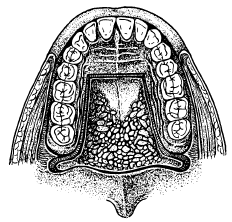
Figure 1-26. Minor Palatine Salivary Glands
v
The Temporomandibular Joint
n Overview (Figure 1-27)
The right and left temporomandibular joints are the two places where the
mandible connects with the rest of the skull. In general terms, the
temporomandibular joint is formed by the glenoid fossa and articular
eminence of the temporal bone and by the condyle of the mandible. The
fossa and eminence are separated from contact with the condyle by an articular
disc.
n
Temporomandibular Joint Structure
¨ Glenoid Fossa
The glenoid fossa is a deep hollow on the under surface of the
zygomatic process of the temporal bone. The base of the zygomatic process is the
place where the process originates from the central mass of the temporal bone.
The condyle stays in the fossa during ordinary opening and closing (hinge)
movements.
¨
Articular Eminence
The articular eminence is a ramp-shaped prominence which extends
forward and downward from the anterior boundary of the glenoid fossa. During
forward (protrusive) movements of the entire mandible, both condyles leave
their fossae and move onto eminences. In lateral movements, one condyle
usually stays in a fossa and the other condyle moves out of the fossa onto its
eminence.
¨ Condyle
The condyle is the oval- or kidney-shaped structure found on the end
of the condyloid process of the mandible.
¨ Articular Disc
The articular disc is a pad of tough, flexible fibrocartilage situated
between the condyle and the glenoid fossa. The disc is a shock absorbing
mechanism. When the condyle moves out onto the articular eminence the disc
travels with it.
¨ Synovial Cavities
The synovial cavities are also referred to as the upper and lower
joint compartments:
 |
Upper. The upper
synovial cavity is found between the top of the disc and the glenoid fossa. |
 |
Lower. The lower synovial cavity is found between the bottom of
the disc and the condyle of the mandible. |
¨ Synovial Membrane and Associated Synovial Fluid
The synovial membrane is the lining of a synovial cavity. The
cells of the lining make a lubricating liquid called synovial fluid.
¨ Capsule
The capsule is the major ligament of the temporomandibular joint. This
ligamentous sleeve or capsule originates from the entire rim of the glenoid
fossa and articular eminence, attaches to the edges of the articular disc, and
passes to insert around the rim of the condyle. The capsule holds the disc in
place between the condyle and the fossa, it retains the synovial fluid in the
upper and lower joint compartments, and it acts to prevent dislocation of the
mandible. Some authors of anatomy texts mention a temporomandibular ligament,
which is an anterior thickening of the capsule, not a separate ligament.
¨ Auxiliary Ligaments (Figure
1-28)
Auxiliary ligaments generally act to restrict the condyle to a normal
range movement and prevent dislocation:
 |
Stylomandibular Ligament. The stylomandibular ligament
originates on the styloid process of the temporal bone and inserts on the
posterior border of the ramus near the angle. |
 |
Sphenomandibular Ligament. The sphenomandibular ligament
originates on the spine of the sphenoid bone and inserts on the anterior
superior of the mandibular foramen (lingula). The mandibular
foramen is found on the internal surface of the ramus of the mandible. |
n
Basic Mandibular Movements
¨
Opening and Closing
From a position of centric relation, pure hinge movements are possible in
opening and closing. In a hinge movement, the condyles rotate within the
glenoid fossa. Opening and
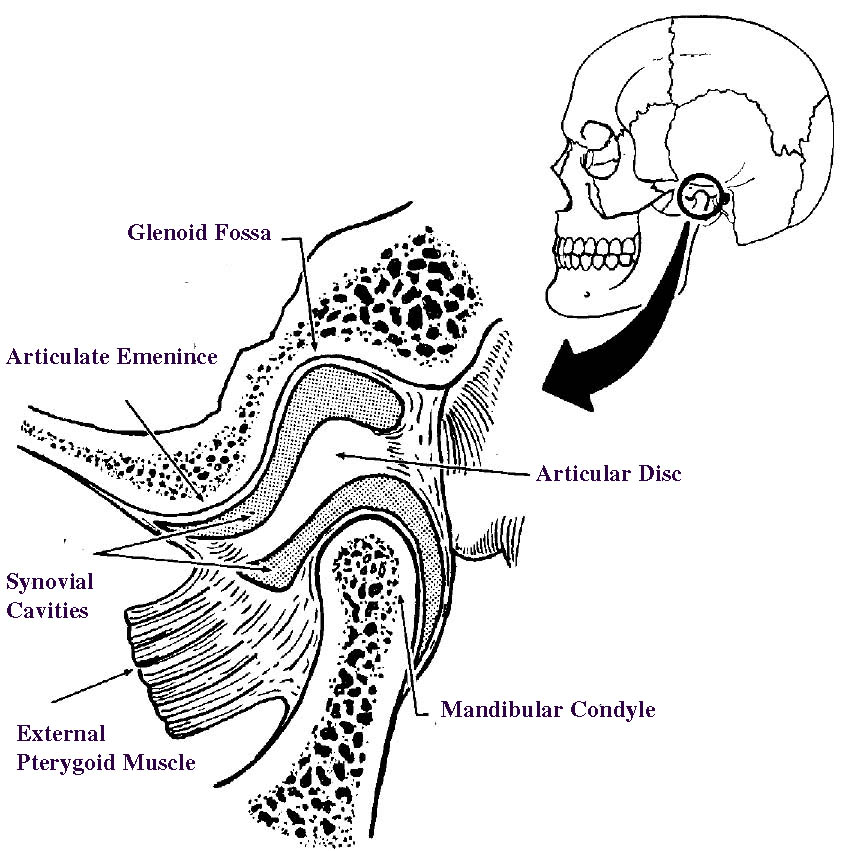
Figure 1-27. Temporomandibular Joint
closing movements, where the measured distance between
maxillary and mandibular incisors is greater than 25 mm, result in combined
rotation and translation of the condyles. Translation occurs whenever a condyle
leaves the glenoid fossa.
¨ Protrusion and Retrusion
Protrusion is when the mandible moves forward and both
condyles leave their respective fossae and move down their eminences. The
opposite process is called retrusion. Protrusion and retrusion are
translatory movements.
¨ Right and Left Lateral
 |
Working Side. The side toward which the mandible moves. When the
mandible moves laterally, the condyle on the working side stays in its fossa,
rotates and moves laterally. |
 |
Balancing Side. The side opposite the working side. In a lateral
movement, the balancing side condyle leaves the fossa and moves forward down
the eminence, and medially. |
